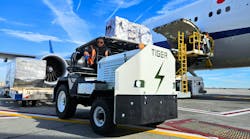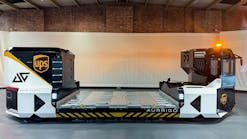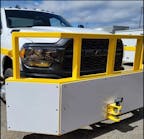To support baggage handling as well as a multitude of airport tarmac operations, including lavatory services, potable water service and maintenance operations, Waev Inc. has expanded its line of all-electric utility vehicles with the Bigfoot XL product range.
The overall Bigfoot product line began with the Bigfoot, “the original,” which has a load capacity of 3,000 pounds, towing capacity of 7,500 pounds, a 48-volt electric – including lithium-ion (Li-ion) – configuration and a 60-mile range. The flagship Bigfoot burden carrier remains Waev’s most popular model today, says Gerry Hoadley, director of ground support equipment at Waev Inc.
“It was designed for the widest range of applications and operating environments,” he adds.
In fact, Hoadley says they can effectively replace multiple vehicles, such as trucks, utility terrain vehicles (UTVs) and maintenance vehicles by offering a single versatile solution for ground support operations.
Bigfoot XL
An increased towing capacity (10,000 lbs. total, or 2,500 lbs. more than the original) comes with the Bigfoot XL. Engineered with the DNA that Bigfoot vehicles are known for, Hoadley says the Bigfoot XL boasts all-steel construction resulting in enhanced durability.
“The Bigfoot XL is simple to operate, simple to maintain, and is an easy way to start going electric. Bigfoot is also purposely built for operations like airports – unlike trucks which are built for highways, golf carts which are built for the golf course, and side-by-sides which are built for off-roading,” says Hoadley.
Electric GSE
With flexible charging and battery options, Bigfoot burden carriers can adapt to the widest range of infrastructure readiness – breaking down adoption barriers and simplifying the transition to electric. Hoadley says infrastructure requirements can scale with the fleet, starting with dedicated 110v-240v single phase outlets.
“Bigfoot burden carriers can plug into the same outlet as a smart phone for easy overnight charging that requires no immediate infrastructure changes. If a faster charge is required, Bigfoot models equipped with Li-ion batteries can be equipped to charge using approved off-board DC fast chargers,” Hoadley says.
Li-ion power further enhances productivity with increased uptime and performance power.
“Advanced Li-ion batteries provide at least 3,000 cycles and the greatest efficiency without power loss as the battery charge depletes. Li-ion batteries last significantly longer than flooded lead-acid or AGM batteries – up to five times as long – and don’t require maintenance such as posts to be cleaned or fluid to be monitored or added. Additionally, we use LiFePO4 cells, which is known to be one of the most stable lithium chemistries in the battery industry. At the end of the serviceable life of power modules with LiFePO4 cells, the cells can be utilized for energy storage in things such as power walls and off-grid power sources,” says Hoadley.
A battery disconnect feature on the Bigfoot XL cuts off power after 10 minutes of inactivity, eliminating unnecessary battery wear and tear and extending vehicle longevity.
Bigfoot burden carriers are engineered with safety in mind, according to Hoadley, who notes the ergonomically low step height and high visibility for operators. A maximum speed of 18 mph can be adjusted to meet compliance standards, further helping to safeguard employees around busy operations. Other safety features include an emergency stop, operator presence switch, beacon lights, horn and backup alarm.
Customizable options include full cabs, bed enclosures, integrated racks and other accessories that add to their versatility with customizations for baggage handling, maintenance, ambulance, law enforcement and people movers.
For those who decide the Bigfoot XL and the original Bigfoot are too big, there’s the Bigfoot S. The compact utility vehicle with tighter tuns has a load capacity of 2,000 pounds, towing compacity of 5,000 pounds and a 40-to-50-mile range.
Expanded Lineup
In September 2023, Waev expanded its Bigfoot XL lineup to add trucks specifically designed for aviation ground support. They are the Bigfoot XL Baggage Truck, Lavatory Truck and Potable Water Truck.
The Bigfoot XL Baggage Truck features 85 cubic feet of covered storage and a 10,000 lb. towing capacity, ideal for efficient luggage transport. This baggage truck was designed for airport operations that typically move three or fewer baggage carts at a time, says Hoadley, noting that’s beneficial for tail-to-tail operations moving baggage between connecting flights.
The Bigfoot XL Lavatory Truck is a self-contained lavatory service truck engineered to easily service smaller aircraft with a 215-gallon total capacity. The truck features a 12-volt pump and 110-volt shore power connection for space and water heating, as well as a fill level sight gauge, standard aircraft lavatory service couplings, and a resettable flow meter.
With a 175-gallon total capacity, 12-volt pump and 110-volt shore power connection, the self-contained Bigfoot XL Potable Water Service Truck is also engineered to easily service smaller aircraft on the tarmac. Additional features include a fill level gauge, large cleanout hatch and 6.5 cubic feet of cargo space.
Hoadley notes the lavatory and potable water service trucks are ideal for regional airports with lower turn frequencies.









